E-Portfolio: Creating Safe, Inclusive Spaces in Early Years (107 HSC)
VerifiedAdded on 2023/06/10
|11
|3194
|162
Portfolio
AI Summary
This e-portfolio focuses on promoting a safe and inclusive environment within early years education, emphasizing the importance of creating spaces where children from diverse backgrounds feel secure, respected, and valued. It highlights the guiding principles of the Early Years Foundation Stage (EYFS) policy, which emphasizes the uniqueness of each child, the significance of positive relationships, and the need for enabling environments. The portfolio addresses cultural tensions, children's queries about cultural differences, and age-specific realizations regarding diversity. It underscores the role of practitioners in fostering cultural competence through various activities like celebrating cultural events, providing multicultural resources, and being responsive to children's questions. It emphasizes the need for professionals to be culturally sensitive, acknowledge observations, explain differences, and promote respectful attitudes. The portfolio ultimately advocates for creating an environment where children can learn from one another and develop into culturally aware and accepting individuals. Desklib provides students access to similar solved assignments and study resources.
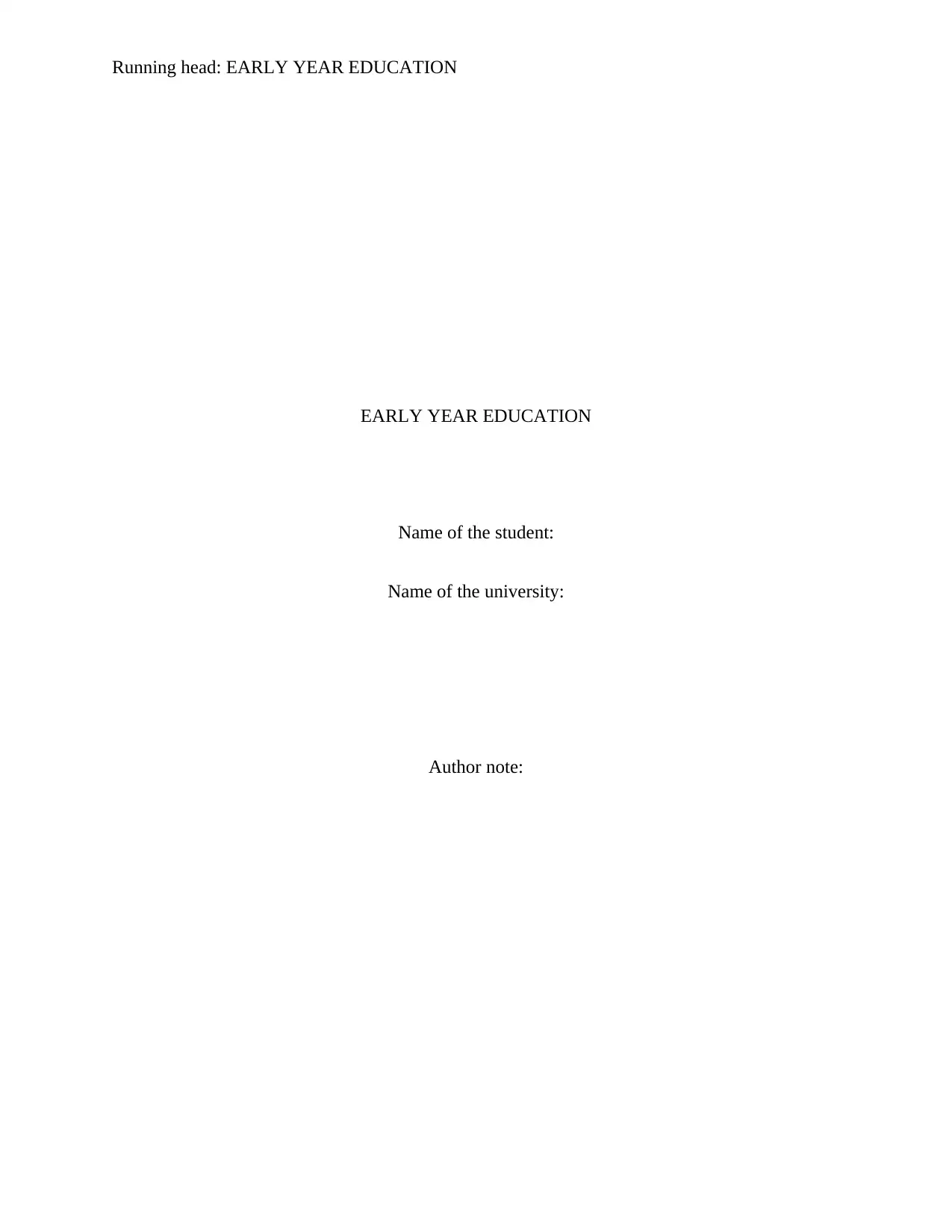
Running head: EARLY YEAR EDUCATION
EARLY YEAR EDUCATION
Name of the student:
Name of the university:
Author note:
EARLY YEAR EDUCATION
Name of the student:
Name of the university:
Author note:
Paraphrase This Document
Need a fresh take? Get an instant paraphrase of this document with our AI Paraphraser
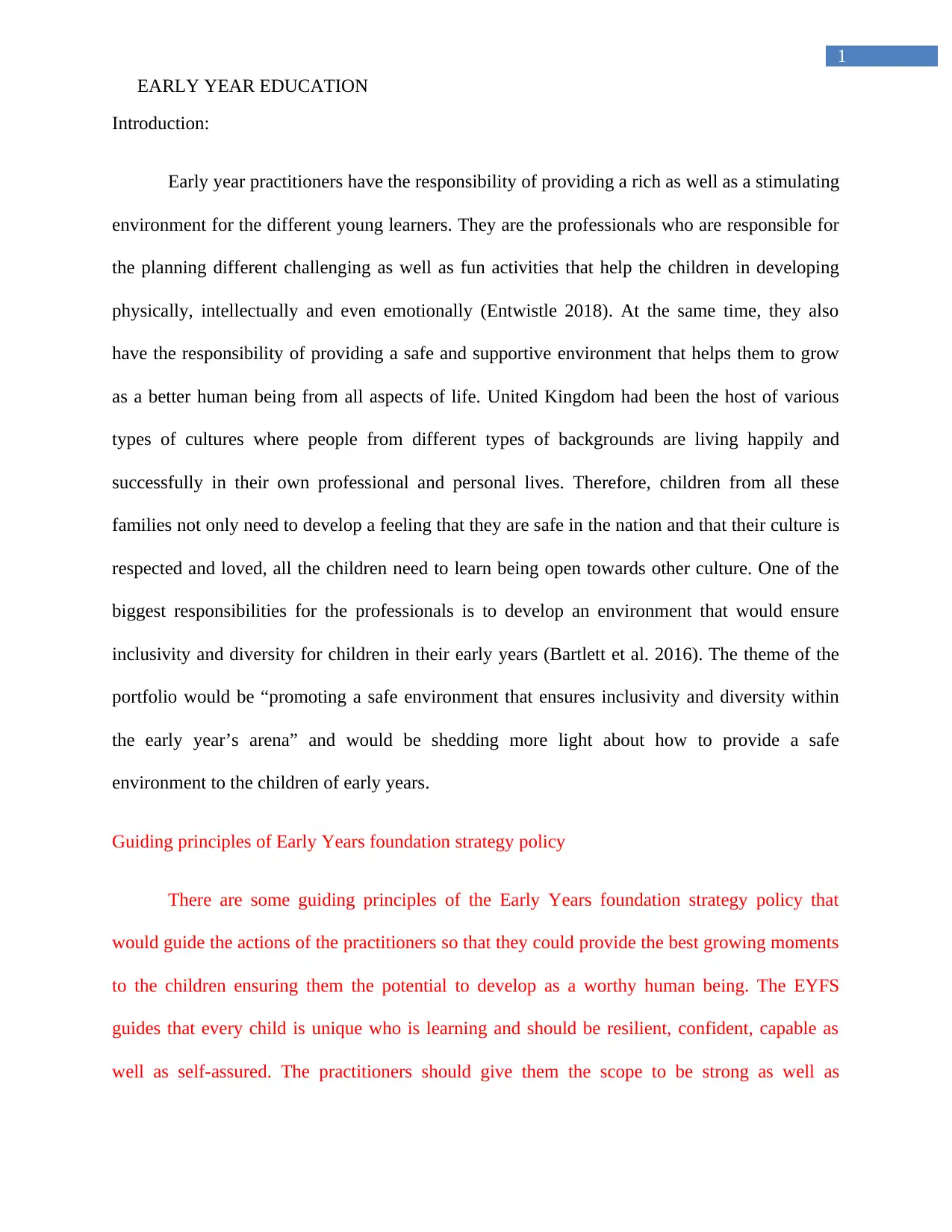
1
EARLY YEAR EDUCATION
Introduction:
Early year practitioners have the responsibility of providing a rich as well as a stimulating
environment for the different young learners. They are the professionals who are responsible for
the planning different challenging as well as fun activities that help the children in developing
physically, intellectually and even emotionally (Entwistle 2018). At the same time, they also
have the responsibility of providing a safe and supportive environment that helps them to grow
as a better human being from all aspects of life. United Kingdom had been the host of various
types of cultures where people from different types of backgrounds are living happily and
successfully in their own professional and personal lives. Therefore, children from all these
families not only need to develop a feeling that they are safe in the nation and that their culture is
respected and loved, all the children need to learn being open towards other culture. One of the
biggest responsibilities for the professionals is to develop an environment that would ensure
inclusivity and diversity for children in their early years (Bartlett et al. 2016). The theme of the
portfolio would be “promoting a safe environment that ensures inclusivity and diversity within
the early year’s arena” and would be shedding more light about how to provide a safe
environment to the children of early years.
Guiding principles of Early Years foundation strategy policy
There are some guiding principles of the Early Years foundation strategy policy that
would guide the actions of the practitioners so that they could provide the best growing moments
to the children ensuring them the potential to develop as a worthy human being. The EYFS
guides that every child is unique who is learning and should be resilient, confident, capable as
well as self-assured. The practitioners should give them the scope to be strong as well as
EARLY YEAR EDUCATION
Introduction:
Early year practitioners have the responsibility of providing a rich as well as a stimulating
environment for the different young learners. They are the professionals who are responsible for
the planning different challenging as well as fun activities that help the children in developing
physically, intellectually and even emotionally (Entwistle 2018). At the same time, they also
have the responsibility of providing a safe and supportive environment that helps them to grow
as a better human being from all aspects of life. United Kingdom had been the host of various
types of cultures where people from different types of backgrounds are living happily and
successfully in their own professional and personal lives. Therefore, children from all these
families not only need to develop a feeling that they are safe in the nation and that their culture is
respected and loved, all the children need to learn being open towards other culture. One of the
biggest responsibilities for the professionals is to develop an environment that would ensure
inclusivity and diversity for children in their early years (Bartlett et al. 2016). The theme of the
portfolio would be “promoting a safe environment that ensures inclusivity and diversity within
the early year’s arena” and would be shedding more light about how to provide a safe
environment to the children of early years.
Guiding principles of Early Years foundation strategy policy
There are some guiding principles of the Early Years foundation strategy policy that
would guide the actions of the practitioners so that they could provide the best growing moments
to the children ensuring them the potential to develop as a worthy human being. The EYFS
guides that every child is unique who is learning and should be resilient, confident, capable as
well as self-assured. The practitioners should give them the scope to be strong as well as
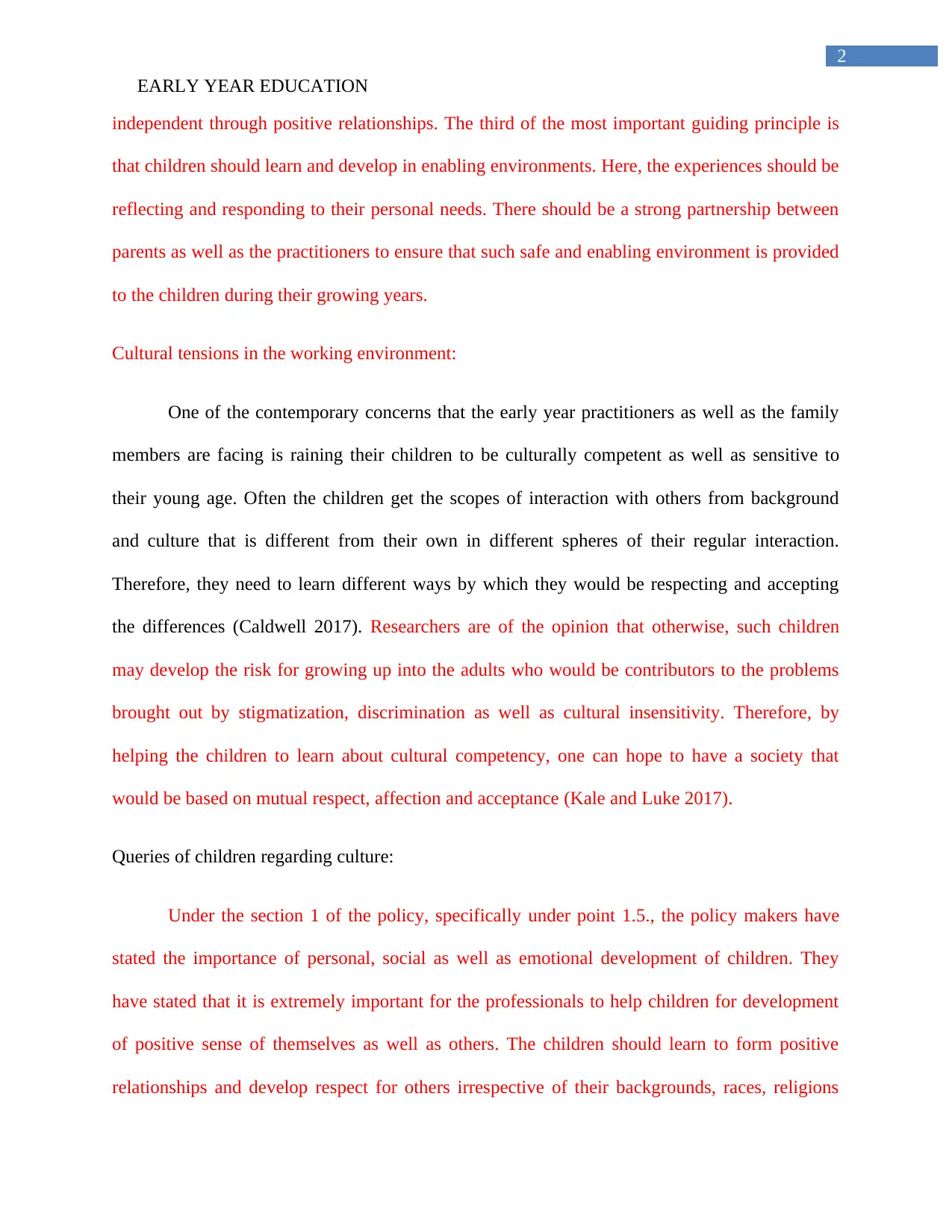
2
EARLY YEAR EDUCATION
independent through positive relationships. The third of the most important guiding principle is
that children should learn and develop in enabling environments. Here, the experiences should be
reflecting and responding to their personal needs. There should be a strong partnership between
parents as well as the practitioners to ensure that such safe and enabling environment is provided
to the children during their growing years.
Cultural tensions in the working environment:
One of the contemporary concerns that the early year practitioners as well as the family
members are facing is raining their children to be culturally competent as well as sensitive to
their young age. Often the children get the scopes of interaction with others from background
and culture that is different from their own in different spheres of their regular interaction.
Therefore, they need to learn different ways by which they would be respecting and accepting
the differences (Caldwell 2017). Researchers are of the opinion that otherwise, such children
may develop the risk for growing up into the adults who would be contributors to the problems
brought out by stigmatization, discrimination as well as cultural insensitivity. Therefore, by
helping the children to learn about cultural competency, one can hope to have a society that
would be based on mutual respect, affection and acceptance (Kale and Luke 2017).
Queries of children regarding culture:
Under the section 1 of the policy, specifically under point 1.5., the policy makers have
stated the importance of personal, social as well as emotional development of children. They
have stated that it is extremely important for the professionals to help children for development
of positive sense of themselves as well as others. The children should learn to form positive
relationships and develop respect for others irrespective of their backgrounds, races, religions
EARLY YEAR EDUCATION
independent through positive relationships. The third of the most important guiding principle is
that children should learn and develop in enabling environments. Here, the experiences should be
reflecting and responding to their personal needs. There should be a strong partnership between
parents as well as the practitioners to ensure that such safe and enabling environment is provided
to the children during their growing years.
Cultural tensions in the working environment:
One of the contemporary concerns that the early year practitioners as well as the family
members are facing is raining their children to be culturally competent as well as sensitive to
their young age. Often the children get the scopes of interaction with others from background
and culture that is different from their own in different spheres of their regular interaction.
Therefore, they need to learn different ways by which they would be respecting and accepting
the differences (Caldwell 2017). Researchers are of the opinion that otherwise, such children
may develop the risk for growing up into the adults who would be contributors to the problems
brought out by stigmatization, discrimination as well as cultural insensitivity. Therefore, by
helping the children to learn about cultural competency, one can hope to have a society that
would be based on mutual respect, affection and acceptance (Kale and Luke 2017).
Queries of children regarding culture:
Under the section 1 of the policy, specifically under point 1.5., the policy makers have
stated the importance of personal, social as well as emotional development of children. They
have stated that it is extremely important for the professionals to help children for development
of positive sense of themselves as well as others. The children should learn to form positive
relationships and develop respect for others irrespective of their backgrounds, races, religions
⊘ This is a preview!⊘
Do you want full access?
Subscribe today to unlock all pages.

Trusted by 1+ million students worldwide
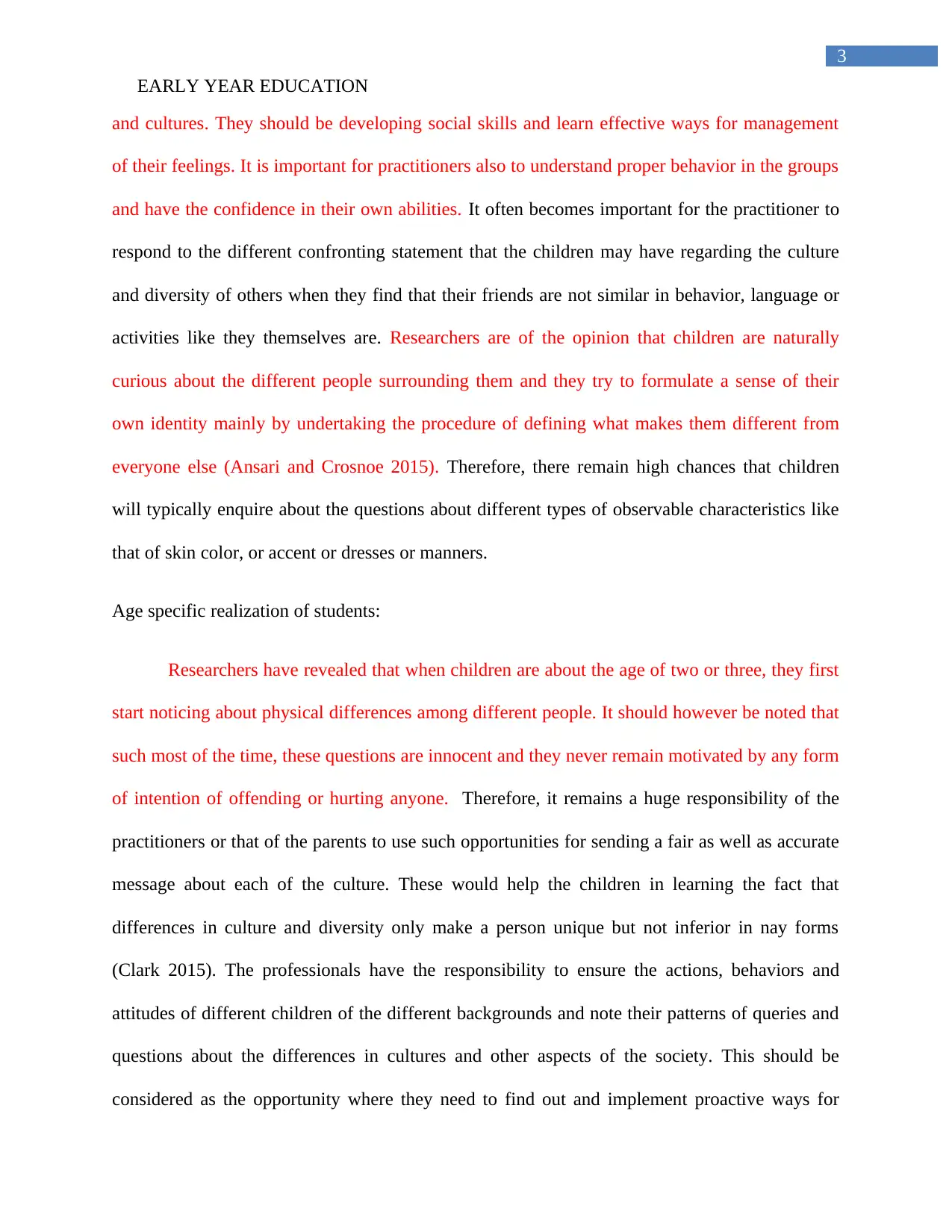
3
EARLY YEAR EDUCATION
and cultures. They should be developing social skills and learn effective ways for management
of their feelings. It is important for practitioners also to understand proper behavior in the groups
and have the confidence in their own abilities. It often becomes important for the practitioner to
respond to the different confronting statement that the children may have regarding the culture
and diversity of others when they find that their friends are not similar in behavior, language or
activities like they themselves are. Researchers are of the opinion that children are naturally
curious about the different people surrounding them and they try to formulate a sense of their
own identity mainly by undertaking the procedure of defining what makes them different from
everyone else (Ansari and Crosnoe 2015). Therefore, there remain high chances that children
will typically enquire about the questions about different types of observable characteristics like
that of skin color, or accent or dresses or manners.
Age specific realization of students:
Researchers have revealed that when children are about the age of two or three, they first
start noticing about physical differences among different people. It should however be noted that
such most of the time, these questions are innocent and they never remain motivated by any form
of intention of offending or hurting anyone. Therefore, it remains a huge responsibility of the
practitioners or that of the parents to use such opportunities for sending a fair as well as accurate
message about each of the culture. These would help the children in learning the fact that
differences in culture and diversity only make a person unique but not inferior in nay forms
(Clark 2015). The professionals have the responsibility to ensure the actions, behaviors and
attitudes of different children of the different backgrounds and note their patterns of queries and
questions about the differences in cultures and other aspects of the society. This should be
considered as the opportunity where they need to find out and implement proactive ways for
EARLY YEAR EDUCATION
and cultures. They should be developing social skills and learn effective ways for management
of their feelings. It is important for practitioners also to understand proper behavior in the groups
and have the confidence in their own abilities. It often becomes important for the practitioner to
respond to the different confronting statement that the children may have regarding the culture
and diversity of others when they find that their friends are not similar in behavior, language or
activities like they themselves are. Researchers are of the opinion that children are naturally
curious about the different people surrounding them and they try to formulate a sense of their
own identity mainly by undertaking the procedure of defining what makes them different from
everyone else (Ansari and Crosnoe 2015). Therefore, there remain high chances that children
will typically enquire about the questions about different types of observable characteristics like
that of skin color, or accent or dresses or manners.
Age specific realization of students:
Researchers have revealed that when children are about the age of two or three, they first
start noticing about physical differences among different people. It should however be noted that
such most of the time, these questions are innocent and they never remain motivated by any form
of intention of offending or hurting anyone. Therefore, it remains a huge responsibility of the
practitioners or that of the parents to use such opportunities for sending a fair as well as accurate
message about each of the culture. These would help the children in learning the fact that
differences in culture and diversity only make a person unique but not inferior in nay forms
(Clark 2015). The professionals have the responsibility to ensure the actions, behaviors and
attitudes of different children of the different backgrounds and note their patterns of queries and
questions about the differences in cultures and other aspects of the society. This should be
considered as the opportunity where they need to find out and implement proactive ways for
Paraphrase This Document
Need a fresh take? Get an instant paraphrase of this document with our AI Paraphraser
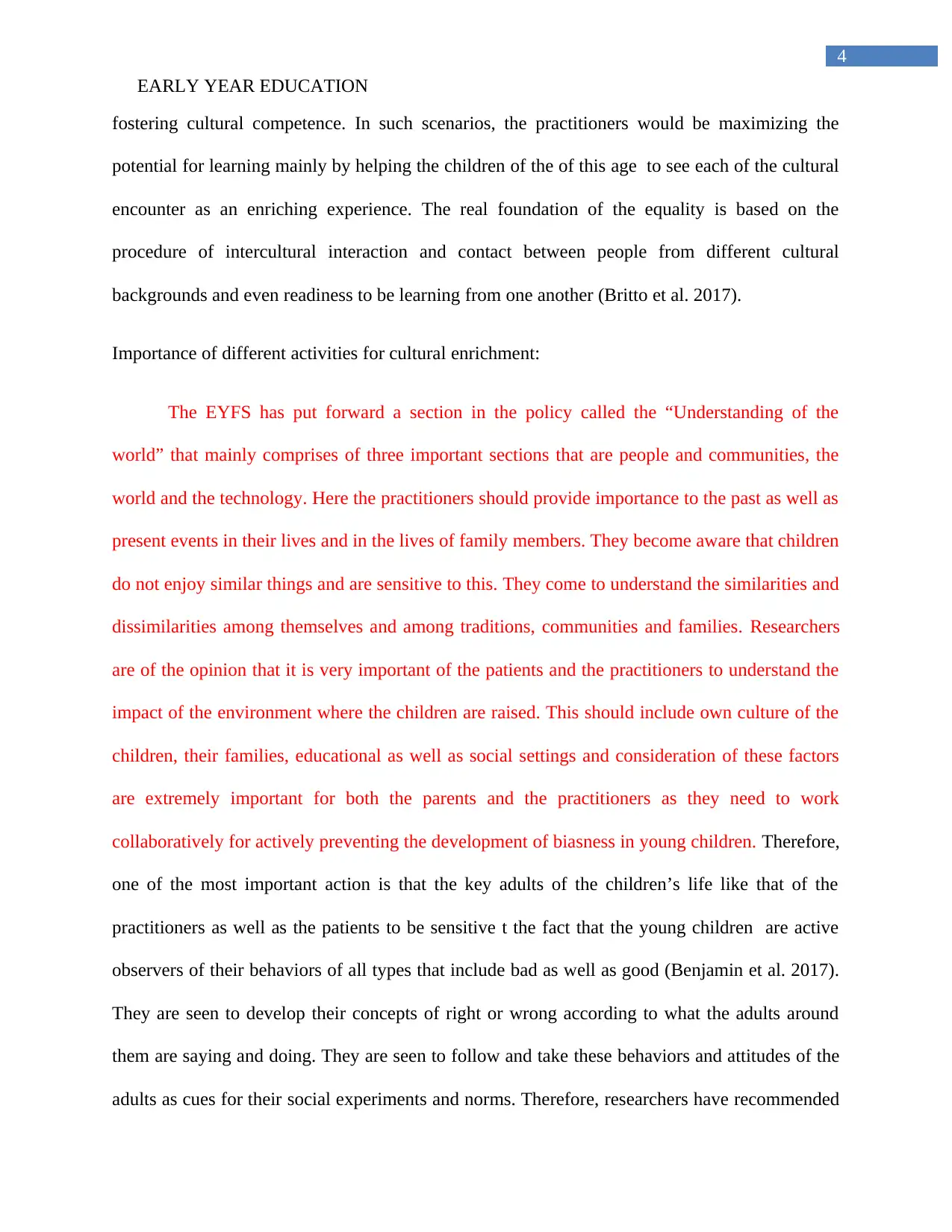
4
EARLY YEAR EDUCATION
fostering cultural competence. In such scenarios, the practitioners would be maximizing the
potential for learning mainly by helping the children of the of this age to see each of the cultural
encounter as an enriching experience. The real foundation of the equality is based on the
procedure of intercultural interaction and contact between people from different cultural
backgrounds and even readiness to be learning from one another (Britto et al. 2017).
Importance of different activities for cultural enrichment:
The EYFS has put forward a section in the policy called the “Understanding of the
world” that mainly comprises of three important sections that are people and communities, the
world and the technology. Here the practitioners should provide importance to the past as well as
present events in their lives and in the lives of family members. They become aware that children
do not enjoy similar things and are sensitive to this. They come to understand the similarities and
dissimilarities among themselves and among traditions, communities and families. Researchers
are of the opinion that it is very important of the patients and the practitioners to understand the
impact of the environment where the children are raised. This should include own culture of the
children, their families, educational as well as social settings and consideration of these factors
are extremely important for both the parents and the practitioners as they need to work
collaboratively for actively preventing the development of biasness in young children. Therefore,
one of the most important action is that the key adults of the children’s life like that of the
practitioners as well as the patients to be sensitive t the fact that the young children are active
observers of their behaviors of all types that include bad as well as good (Benjamin et al. 2017).
They are seen to develop their concepts of right or wrong according to what the adults around
them are saying and doing. They are seen to follow and take these behaviors and attitudes of the
adults as cues for their social experiments and norms. Therefore, researchers have recommended
EARLY YEAR EDUCATION
fostering cultural competence. In such scenarios, the practitioners would be maximizing the
potential for learning mainly by helping the children of the of this age to see each of the cultural
encounter as an enriching experience. The real foundation of the equality is based on the
procedure of intercultural interaction and contact between people from different cultural
backgrounds and even readiness to be learning from one another (Britto et al. 2017).
Importance of different activities for cultural enrichment:
The EYFS has put forward a section in the policy called the “Understanding of the
world” that mainly comprises of three important sections that are people and communities, the
world and the technology. Here the practitioners should provide importance to the past as well as
present events in their lives and in the lives of family members. They become aware that children
do not enjoy similar things and are sensitive to this. They come to understand the similarities and
dissimilarities among themselves and among traditions, communities and families. Researchers
are of the opinion that it is very important of the patients and the practitioners to understand the
impact of the environment where the children are raised. This should include own culture of the
children, their families, educational as well as social settings and consideration of these factors
are extremely important for both the parents and the practitioners as they need to work
collaboratively for actively preventing the development of biasness in young children. Therefore,
one of the most important action is that the key adults of the children’s life like that of the
practitioners as well as the patients to be sensitive t the fact that the young children are active
observers of their behaviors of all types that include bad as well as good (Benjamin et al. 2017).
They are seen to develop their concepts of right or wrong according to what the adults around
them are saying and doing. They are seen to follow and take these behaviors and attitudes of the
adults as cues for their social experiments and norms. Therefore, researchers have recommended
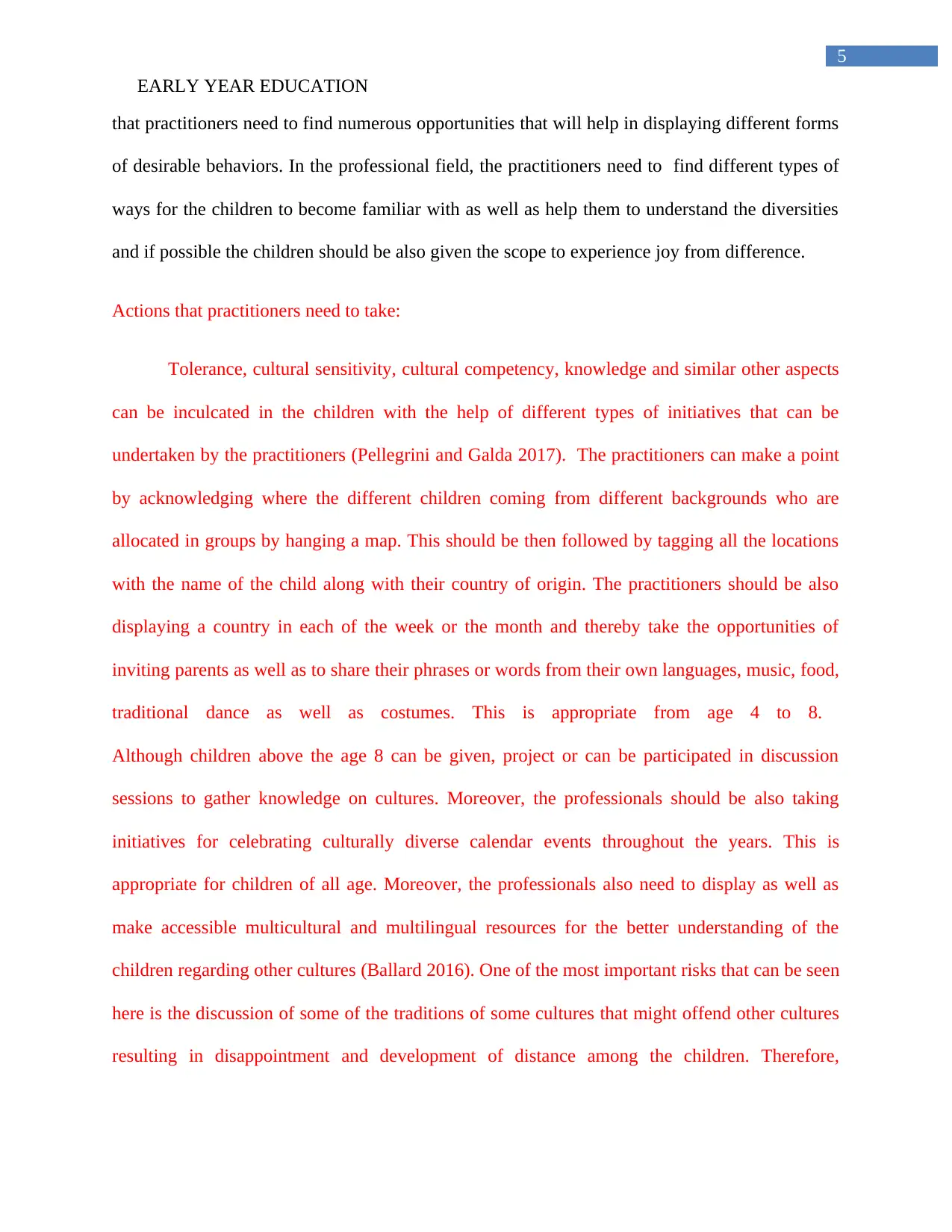
5
EARLY YEAR EDUCATION
that practitioners need to find numerous opportunities that will help in displaying different forms
of desirable behaviors. In the professional field, the practitioners need to find different types of
ways for the children to become familiar with as well as help them to understand the diversities
and if possible the children should be also given the scope to experience joy from difference.
Actions that practitioners need to take:
Tolerance, cultural sensitivity, cultural competency, knowledge and similar other aspects
can be inculcated in the children with the help of different types of initiatives that can be
undertaken by the practitioners (Pellegrini and Galda 2017). The practitioners can make a point
by acknowledging where the different children coming from different backgrounds who are
allocated in groups by hanging a map. This should be then followed by tagging all the locations
with the name of the child along with their country of origin. The practitioners should be also
displaying a country in each of the week or the month and thereby take the opportunities of
inviting parents as well as to share their phrases or words from their own languages, music, food,
traditional dance as well as costumes. This is appropriate from age 4 to 8.
Although children above the age 8 can be given, project or can be participated in discussion
sessions to gather knowledge on cultures. Moreover, the professionals should be also taking
initiatives for celebrating culturally diverse calendar events throughout the years. This is
appropriate for children of all age. Moreover, the professionals also need to display as well as
make accessible multicultural and multilingual resources for the better understanding of the
children regarding other cultures (Ballard 2016). One of the most important risks that can be seen
here is the discussion of some of the traditions of some cultures that might offend other cultures
resulting in disappointment and development of distance among the children. Therefore,
EARLY YEAR EDUCATION
that practitioners need to find numerous opportunities that will help in displaying different forms
of desirable behaviors. In the professional field, the practitioners need to find different types of
ways for the children to become familiar with as well as help them to understand the diversities
and if possible the children should be also given the scope to experience joy from difference.
Actions that practitioners need to take:
Tolerance, cultural sensitivity, cultural competency, knowledge and similar other aspects
can be inculcated in the children with the help of different types of initiatives that can be
undertaken by the practitioners (Pellegrini and Galda 2017). The practitioners can make a point
by acknowledging where the different children coming from different backgrounds who are
allocated in groups by hanging a map. This should be then followed by tagging all the locations
with the name of the child along with their country of origin. The practitioners should be also
displaying a country in each of the week or the month and thereby take the opportunities of
inviting parents as well as to share their phrases or words from their own languages, music, food,
traditional dance as well as costumes. This is appropriate from age 4 to 8.
Although children above the age 8 can be given, project or can be participated in discussion
sessions to gather knowledge on cultures. Moreover, the professionals should be also taking
initiatives for celebrating culturally diverse calendar events throughout the years. This is
appropriate for children of all age. Moreover, the professionals also need to display as well as
make accessible multicultural and multilingual resources for the better understanding of the
children regarding other cultures (Ballard 2016). One of the most important risks that can be seen
here is the discussion of some of the traditions of some cultures that might offend other cultures
resulting in disappointment and development of distance among the children. Therefore,
⊘ This is a preview!⊘
Do you want full access?
Subscribe today to unlock all pages.

Trusted by 1+ million students worldwide
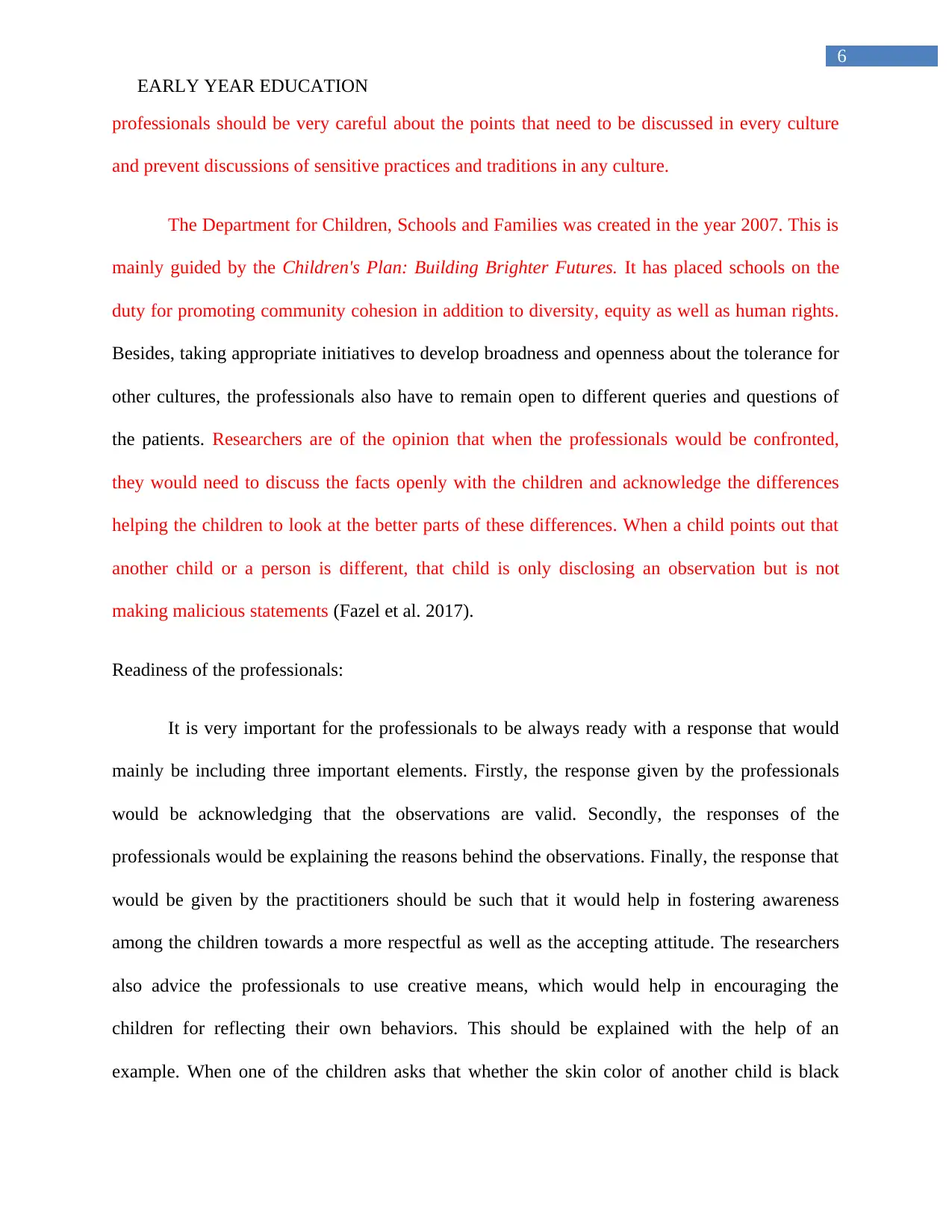
6
EARLY YEAR EDUCATION
professionals should be very careful about the points that need to be discussed in every culture
and prevent discussions of sensitive practices and traditions in any culture.
The Department for Children, Schools and Families was created in the year 2007. This is
mainly guided by the Children's Plan: Building Brighter Futures. It has placed schools on the
duty for promoting community cohesion in addition to diversity, equity as well as human rights.
Besides, taking appropriate initiatives to develop broadness and openness about the tolerance for
other cultures, the professionals also have to remain open to different queries and questions of
the patients. Researchers are of the opinion that when the professionals would be confronted,
they would need to discuss the facts openly with the children and acknowledge the differences
helping the children to look at the better parts of these differences. When a child points out that
another child or a person is different, that child is only disclosing an observation but is not
making malicious statements (Fazel et al. 2017).
Readiness of the professionals:
It is very important for the professionals to be always ready with a response that would
mainly be including three important elements. Firstly, the response given by the professionals
would be acknowledging that the observations are valid. Secondly, the responses of the
professionals would be explaining the reasons behind the observations. Finally, the response that
would be given by the practitioners should be such that it would help in fostering awareness
among the children towards a more respectful as well as the accepting attitude. The researchers
also advice the professionals to use creative means, which would help in encouraging the
children for reflecting their own behaviors. This should be explained with the help of an
example. When one of the children asks that whether the skin color of another child is black
EARLY YEAR EDUCATION
professionals should be very careful about the points that need to be discussed in every culture
and prevent discussions of sensitive practices and traditions in any culture.
The Department for Children, Schools and Families was created in the year 2007. This is
mainly guided by the Children's Plan: Building Brighter Futures. It has placed schools on the
duty for promoting community cohesion in addition to diversity, equity as well as human rights.
Besides, taking appropriate initiatives to develop broadness and openness about the tolerance for
other cultures, the professionals also have to remain open to different queries and questions of
the patients. Researchers are of the opinion that when the professionals would be confronted,
they would need to discuss the facts openly with the children and acknowledge the differences
helping the children to look at the better parts of these differences. When a child points out that
another child or a person is different, that child is only disclosing an observation but is not
making malicious statements (Fazel et al. 2017).
Readiness of the professionals:
It is very important for the professionals to be always ready with a response that would
mainly be including three important elements. Firstly, the response given by the professionals
would be acknowledging that the observations are valid. Secondly, the responses of the
professionals would be explaining the reasons behind the observations. Finally, the response that
would be given by the practitioners should be such that it would help in fostering awareness
among the children towards a more respectful as well as the accepting attitude. The researchers
also advice the professionals to use creative means, which would help in encouraging the
children for reflecting their own behaviors. This should be explained with the help of an
example. When one of the children asks that whether the skin color of another child is black
Paraphrase This Document
Need a fresh take? Get an instant paraphrase of this document with our AI Paraphraser
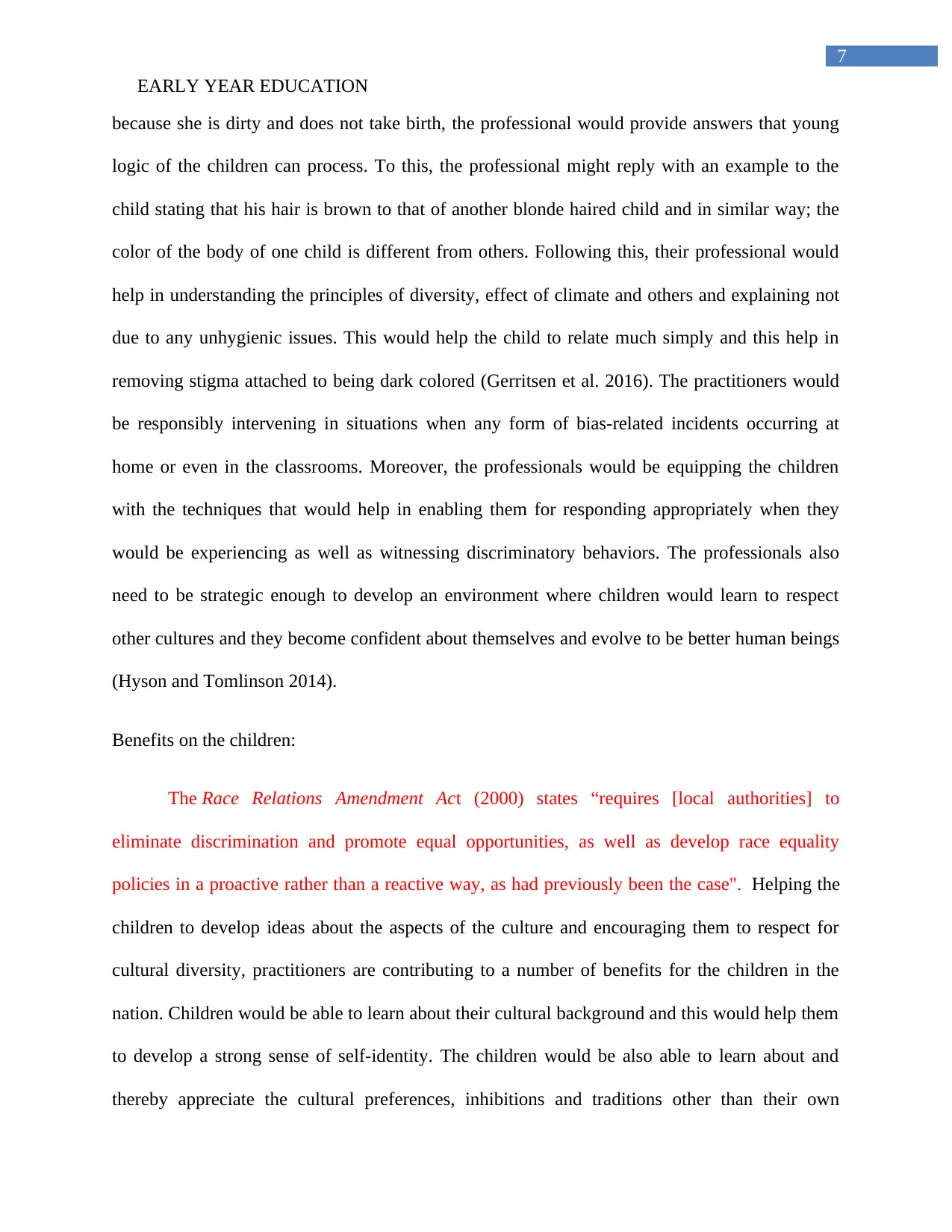
7
EARLY YEAR EDUCATION
because she is dirty and does not take birth, the professional would provide answers that young
logic of the children can process. To this, the professional might reply with an example to the
child stating that his hair is brown to that of another blonde haired child and in similar way; the
color of the body of one child is different from others. Following this, their professional would
help in understanding the principles of diversity, effect of climate and others and explaining not
due to any unhygienic issues. This would help the child to relate much simply and this help in
removing stigma attached to being dark colored (Gerritsen et al. 2016). The practitioners would
be responsibly intervening in situations when any form of bias-related incidents occurring at
home or even in the classrooms. Moreover, the professionals would be equipping the children
with the techniques that would help in enabling them for responding appropriately when they
would be experiencing as well as witnessing discriminatory behaviors. The professionals also
need to be strategic enough to develop an environment where children would learn to respect
other cultures and they become confident about themselves and evolve to be better human beings
(Hyson and Tomlinson 2014).
Benefits on the children:
The Race Relations Amendment Act (2000) states “requires [local authorities] to
eliminate discrimination and promote equal opportunities, as well as develop race equality
policies in a proactive rather than a reactive way, as had previously been the case". Helping the
children to develop ideas about the aspects of the culture and encouraging them to respect for
cultural diversity, practitioners are contributing to a number of benefits for the children in the
nation. Children would be able to learn about their cultural background and this would help them
to develop a strong sense of self-identity. The children would be also able to learn about and
thereby appreciate the cultural preferences, inhibitions and traditions other than their own
EARLY YEAR EDUCATION
because she is dirty and does not take birth, the professional would provide answers that young
logic of the children can process. To this, the professional might reply with an example to the
child stating that his hair is brown to that of another blonde haired child and in similar way; the
color of the body of one child is different from others. Following this, their professional would
help in understanding the principles of diversity, effect of climate and others and explaining not
due to any unhygienic issues. This would help the child to relate much simply and this help in
removing stigma attached to being dark colored (Gerritsen et al. 2016). The practitioners would
be responsibly intervening in situations when any form of bias-related incidents occurring at
home or even in the classrooms. Moreover, the professionals would be equipping the children
with the techniques that would help in enabling them for responding appropriately when they
would be experiencing as well as witnessing discriminatory behaviors. The professionals also
need to be strategic enough to develop an environment where children would learn to respect
other cultures and they become confident about themselves and evolve to be better human beings
(Hyson and Tomlinson 2014).
Benefits on the children:
The Race Relations Amendment Act (2000) states “requires [local authorities] to
eliminate discrimination and promote equal opportunities, as well as develop race equality
policies in a proactive rather than a reactive way, as had previously been the case". Helping the
children to develop ideas about the aspects of the culture and encouraging them to respect for
cultural diversity, practitioners are contributing to a number of benefits for the children in the
nation. Children would be able to learn about their cultural background and this would help them
to develop a strong sense of self-identity. The children would be also able to learn about and
thereby appreciate the cultural preferences, inhibitions and traditions other than their own
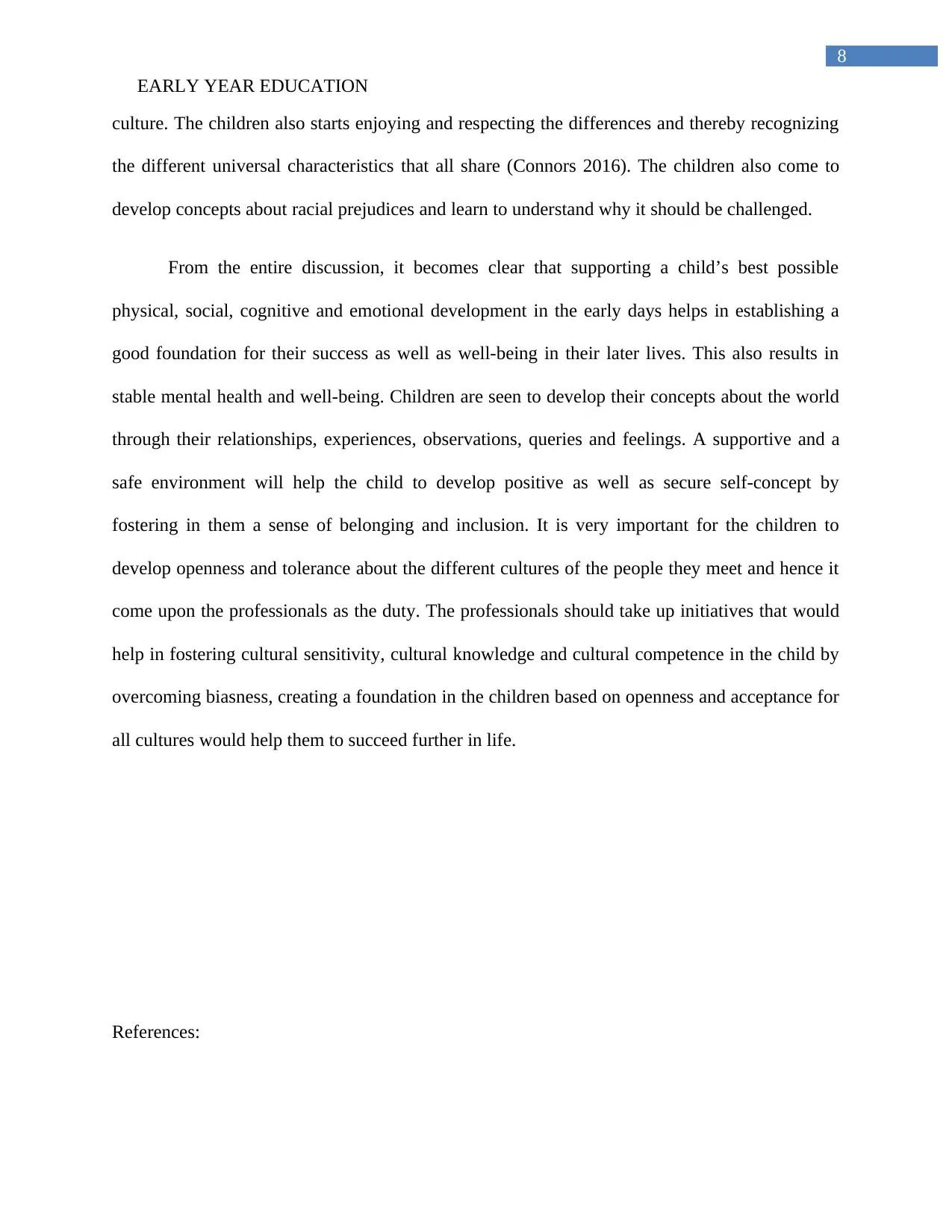
8
EARLY YEAR EDUCATION
culture. The children also starts enjoying and respecting the differences and thereby recognizing
the different universal characteristics that all share (Connors 2016). The children also come to
develop concepts about racial prejudices and learn to understand why it should be challenged.
From the entire discussion, it becomes clear that supporting a child’s best possible
physical, social, cognitive and emotional development in the early days helps in establishing a
good foundation for their success as well as well-being in their later lives. This also results in
stable mental health and well-being. Children are seen to develop their concepts about the world
through their relationships, experiences, observations, queries and feelings. A supportive and a
safe environment will help the child to develop positive as well as secure self-concept by
fostering in them a sense of belonging and inclusion. It is very important for the children to
develop openness and tolerance about the different cultures of the people they meet and hence it
come upon the professionals as the duty. The professionals should take up initiatives that would
help in fostering cultural sensitivity, cultural knowledge and cultural competence in the child by
overcoming biasness, creating a foundation in the children based on openness and acceptance for
all cultures would help them to succeed further in life.
References:
EARLY YEAR EDUCATION
culture. The children also starts enjoying and respecting the differences and thereby recognizing
the different universal characteristics that all share (Connors 2016). The children also come to
develop concepts about racial prejudices and learn to understand why it should be challenged.
From the entire discussion, it becomes clear that supporting a child’s best possible
physical, social, cognitive and emotional development in the early days helps in establishing a
good foundation for their success as well as well-being in their later lives. This also results in
stable mental health and well-being. Children are seen to develop their concepts about the world
through their relationships, experiences, observations, queries and feelings. A supportive and a
safe environment will help the child to develop positive as well as secure self-concept by
fostering in them a sense of belonging and inclusion. It is very important for the children to
develop openness and tolerance about the different cultures of the people they meet and hence it
come upon the professionals as the duty. The professionals should take up initiatives that would
help in fostering cultural sensitivity, cultural knowledge and cultural competence in the child by
overcoming biasness, creating a foundation in the children based on openness and acceptance for
all cultures would help them to succeed further in life.
References:
⊘ This is a preview!⊘
Do you want full access?
Subscribe today to unlock all pages.

Trusted by 1+ million students worldwide
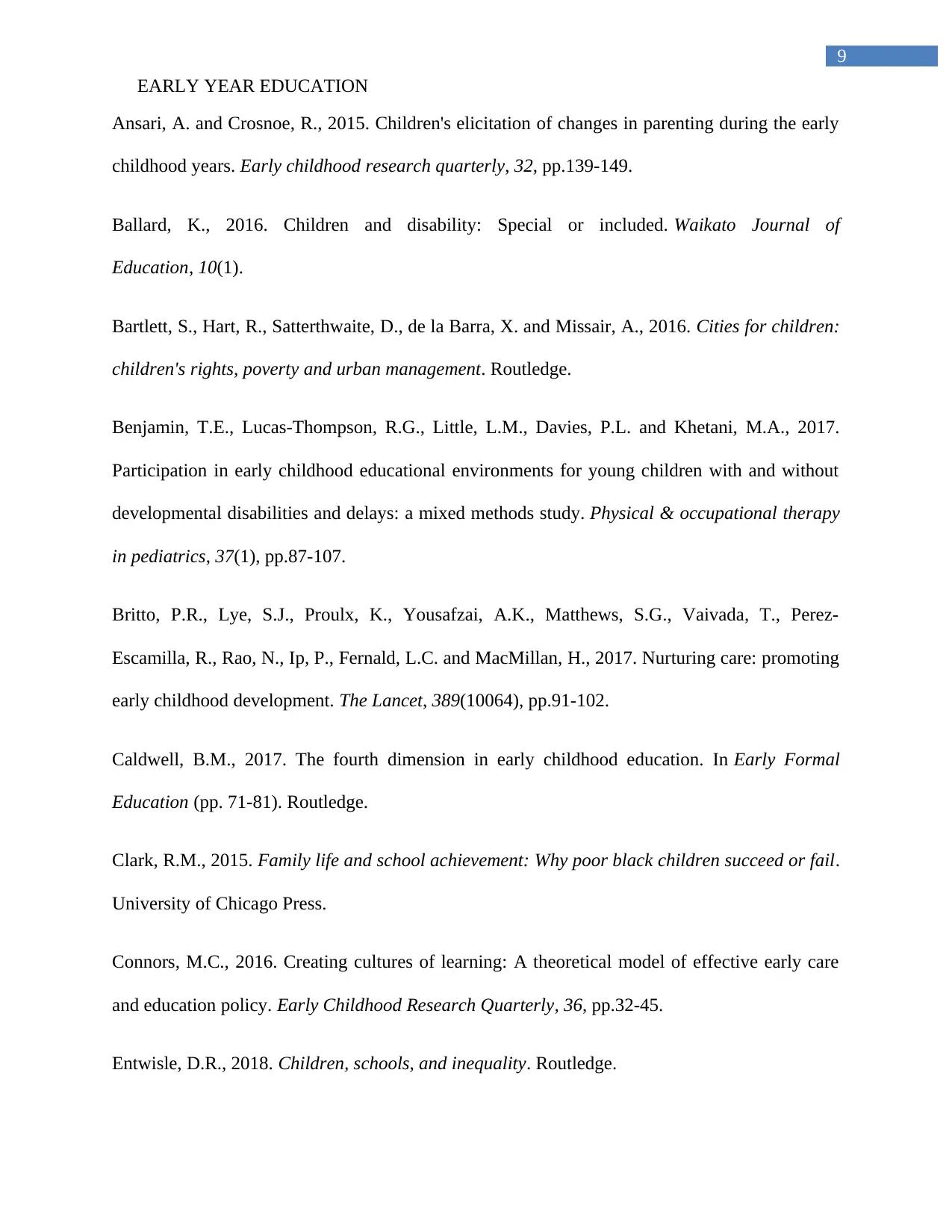
9
EARLY YEAR EDUCATION
Ansari, A. and Crosnoe, R., 2015. Children's elicitation of changes in parenting during the early
childhood years. Early childhood research quarterly, 32, pp.139-149.
Ballard, K., 2016. Children and disability: Special or included. Waikato Journal of
Education, 10(1).
Bartlett, S., Hart, R., Satterthwaite, D., de la Barra, X. and Missair, A., 2016. Cities for children:
children's rights, poverty and urban management. Routledge.
Benjamin, T.E., Lucas-Thompson, R.G., Little, L.M., Davies, P.L. and Khetani, M.A., 2017.
Participation in early childhood educational environments for young children with and without
developmental disabilities and delays: a mixed methods study. Physical & occupational therapy
in pediatrics, 37(1), pp.87-107.
Britto, P.R., Lye, S.J., Proulx, K., Yousafzai, A.K., Matthews, S.G., Vaivada, T., Perez-
Escamilla, R., Rao, N., Ip, P., Fernald, L.C. and MacMillan, H., 2017. Nurturing care: promoting
early childhood development. The Lancet, 389(10064), pp.91-102.
Caldwell, B.M., 2017. The fourth dimension in early childhood education. In Early Formal
Education (pp. 71-81). Routledge.
Clark, R.M., 2015. Family life and school achievement: Why poor black children succeed or fail.
University of Chicago Press.
Connors, M.C., 2016. Creating cultures of learning: A theoretical model of effective early care
and education policy. Early Childhood Research Quarterly, 36, pp.32-45.
Entwisle, D.R., 2018. Children, schools, and inequality. Routledge.
EARLY YEAR EDUCATION
Ansari, A. and Crosnoe, R., 2015. Children's elicitation of changes in parenting during the early
childhood years. Early childhood research quarterly, 32, pp.139-149.
Ballard, K., 2016. Children and disability: Special or included. Waikato Journal of
Education, 10(1).
Bartlett, S., Hart, R., Satterthwaite, D., de la Barra, X. and Missair, A., 2016. Cities for children:
children's rights, poverty and urban management. Routledge.
Benjamin, T.E., Lucas-Thompson, R.G., Little, L.M., Davies, P.L. and Khetani, M.A., 2017.
Participation in early childhood educational environments for young children with and without
developmental disabilities and delays: a mixed methods study. Physical & occupational therapy
in pediatrics, 37(1), pp.87-107.
Britto, P.R., Lye, S.J., Proulx, K., Yousafzai, A.K., Matthews, S.G., Vaivada, T., Perez-
Escamilla, R., Rao, N., Ip, P., Fernald, L.C. and MacMillan, H., 2017. Nurturing care: promoting
early childhood development. The Lancet, 389(10064), pp.91-102.
Caldwell, B.M., 2017. The fourth dimension in early childhood education. In Early Formal
Education (pp. 71-81). Routledge.
Clark, R.M., 2015. Family life and school achievement: Why poor black children succeed or fail.
University of Chicago Press.
Connors, M.C., 2016. Creating cultures of learning: A theoretical model of effective early care
and education policy. Early Childhood Research Quarterly, 36, pp.32-45.
Entwisle, D.R., 2018. Children, schools, and inequality. Routledge.
Paraphrase This Document
Need a fresh take? Get an instant paraphrase of this document with our AI Paraphraser
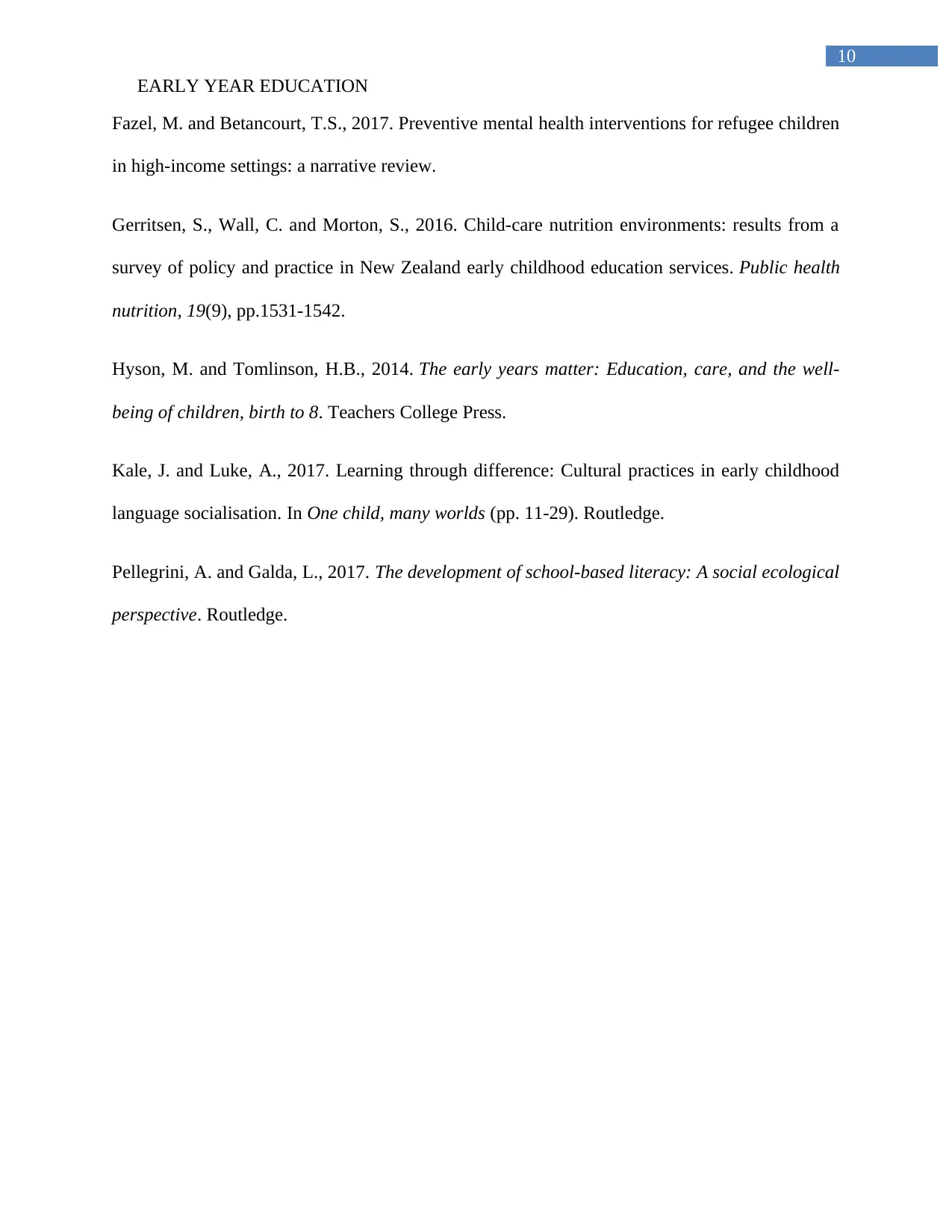
10
EARLY YEAR EDUCATION
Fazel, M. and Betancourt, T.S., 2017. Preventive mental health interventions for refugee children
in high-income settings: a narrative review.
Gerritsen, S., Wall, C. and Morton, S., 2016. Child-care nutrition environments: results from a
survey of policy and practice in New Zealand early childhood education services. Public health
nutrition, 19(9), pp.1531-1542.
Hyson, M. and Tomlinson, H.B., 2014. The early years matter: Education, care, and the well-
being of children, birth to 8. Teachers College Press.
Kale, J. and Luke, A., 2017. Learning through difference: Cultural practices in early childhood
language socialisation. In One child, many worlds (pp. 11-29). Routledge.
Pellegrini, A. and Galda, L., 2017. The development of school-based literacy: A social ecological
perspective. Routledge.
EARLY YEAR EDUCATION
Fazel, M. and Betancourt, T.S., 2017. Preventive mental health interventions for refugee children
in high-income settings: a narrative review.
Gerritsen, S., Wall, C. and Morton, S., 2016. Child-care nutrition environments: results from a
survey of policy and practice in New Zealand early childhood education services. Public health
nutrition, 19(9), pp.1531-1542.
Hyson, M. and Tomlinson, H.B., 2014. The early years matter: Education, care, and the well-
being of children, birth to 8. Teachers College Press.
Kale, J. and Luke, A., 2017. Learning through difference: Cultural practices in early childhood
language socialisation. In One child, many worlds (pp. 11-29). Routledge.
Pellegrini, A. and Galda, L., 2017. The development of school-based literacy: A social ecological
perspective. Routledge.
1 out of 11
Related Documents
Your All-in-One AI-Powered Toolkit for Academic Success.
+13062052269
info@desklib.com
Available 24*7 on WhatsApp / Email
![[object Object]](/_next/static/media/star-bottom.7253800d.svg)
Unlock your academic potential
Copyright © 2020–2025 A2Z Services. All Rights Reserved. Developed and managed by ZUCOL.





